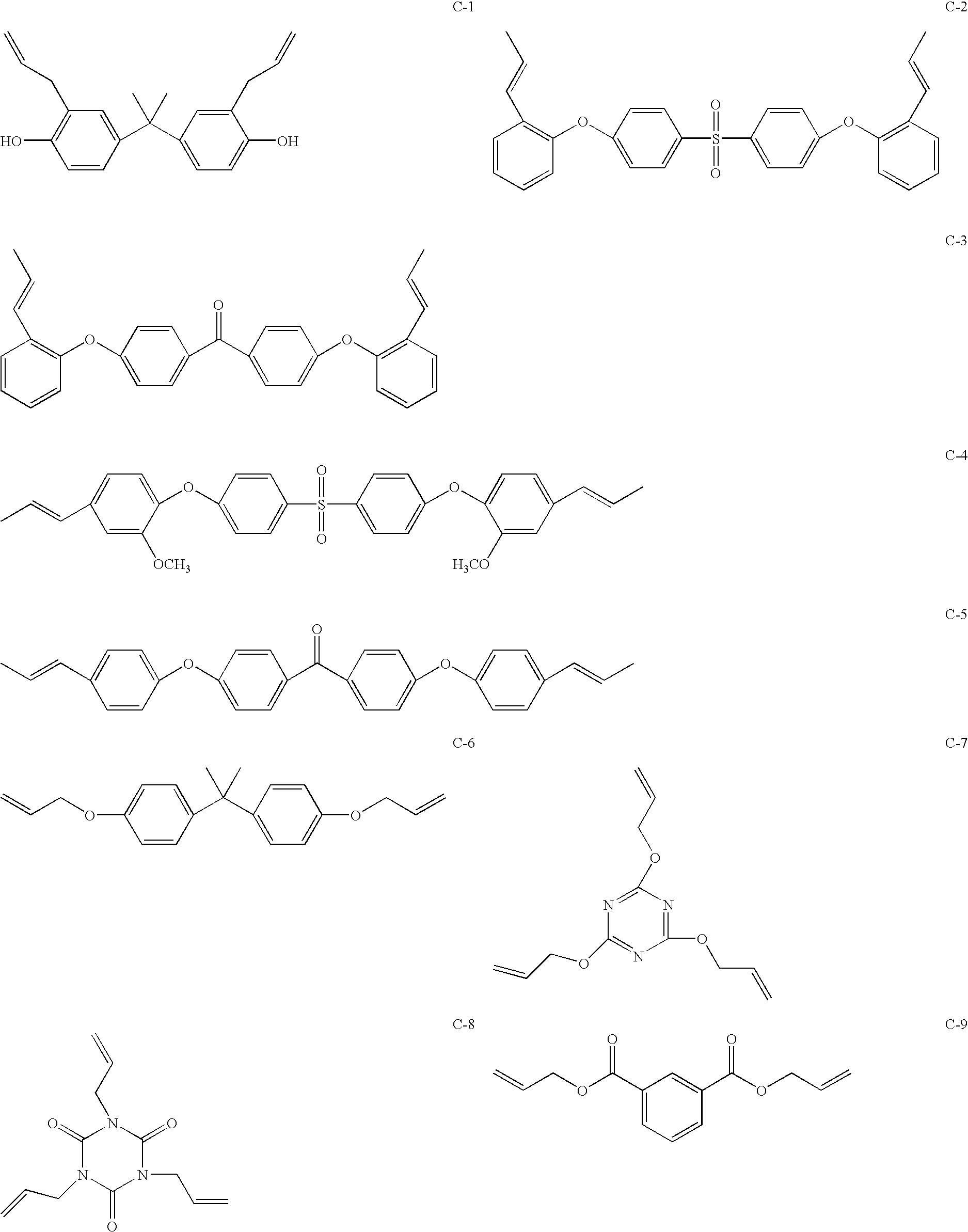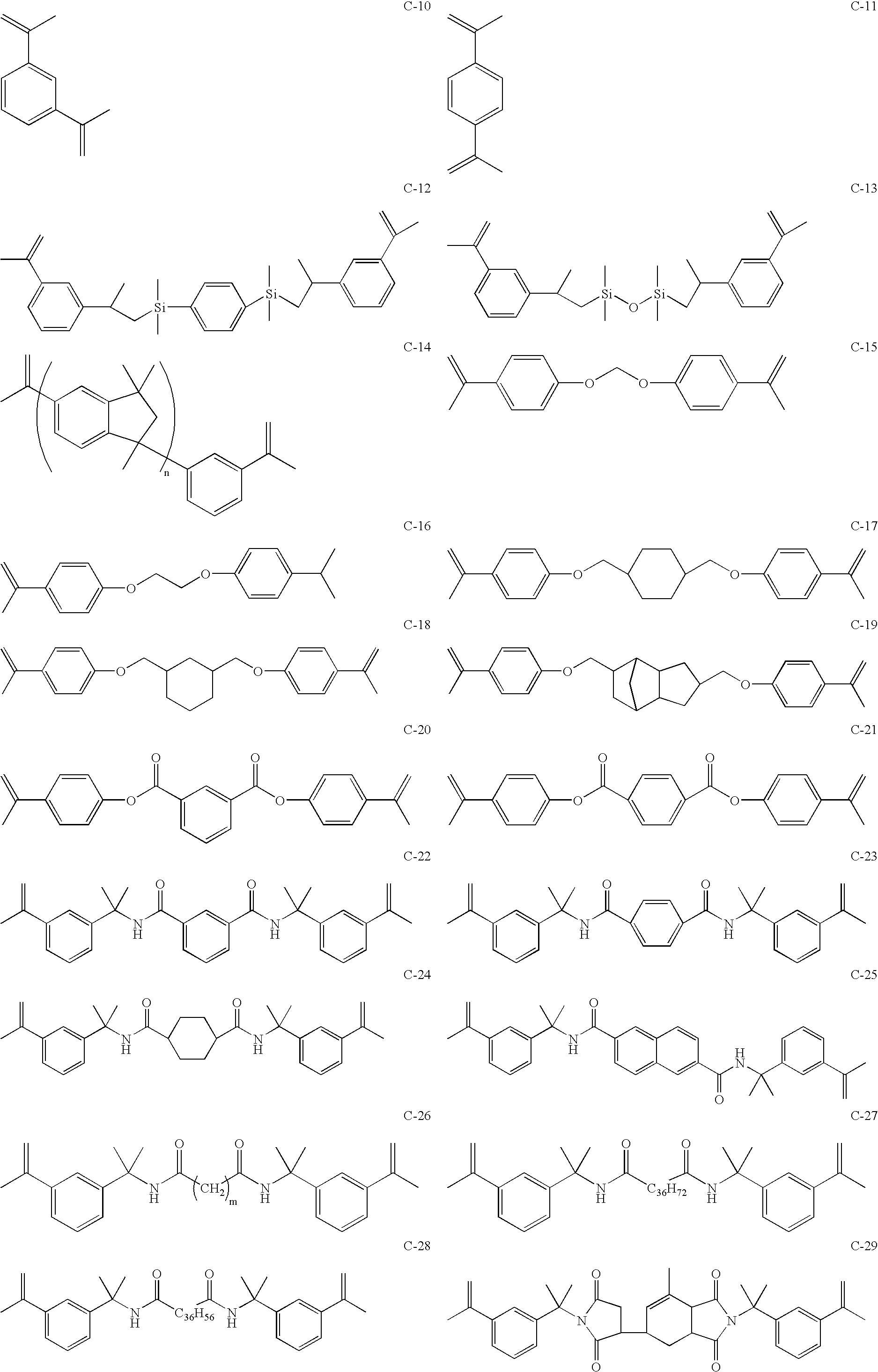Maleimide compositions and methods for use thereof
a composition and composition technology, applied in the field of thermal setting adhesive compositions, can solve the problems of incompatible acidic fluxes required for solder bump re-flow, and other cure chemistries, so as to improve the rate of diels-alder addition reactions, efficient cure of maleimide monomers, and broaden the useful applications
- Summary
- Abstract
- Description
- Claims
- Application Information
AI Technical Summary
Benefits of technology
Problems solved by technology
Method used
Image
Examples
example 1
[0073]3,3′-diallyl-4,4′-diacetoxylbisphenol A (compound “C-33” where R=methyl): A 250 milliliter flask was charged with 30.84 grams (100 millimole) o,o′-diallylbisphenol A (Bixmax's “BX-ODBPA), 20.42 grams (200 millimole) acetic anhydride, and 0.5 grams DMAP catalyst. There was an immediate exotherm. The mixture was stirred at room temperature until the exotherm subsided and the flask was then placed on the rotovap and stirred at a bath temperature of 85° C. for an hour the residual acetic acid was then removed to yield 39.3 grams (100% of theory) of a light orange liquid. The viscosity of this liquid was 2600 centipoise at 25° C. which was substantially lower than the viscosity of the o,o′-diallylbisphenol A starting material (15,400 centipoise at the same temperature). An FTIR spectrum of this compound confirmed the complete absence of phenolic hydroxyl functionality and the appearance of a prominent new absorption at 1759 wavenumbers.
example 2
[0074]Limonene bismaleimide (compound B-1, where both “R” groups=H): A one liter flask was charged with 400 milliliters toluene, 80 grams methane sulfonic acid, and 64 grams of triethylamine. The flask was equipped with a Dean-Stark trap and a condenser and the mixture was stirred at reflux for fifty minutes to remove residual water. Maleic anhydride (86.4 grams, 880 millimoles) along with 150 milligrams BHT was then dissolved into this mixture and 79.36 grams (400 millimoles) of limonene diamine was slowly added to the stirred solution over a period of forty-five minutes. There was an exotherm and a gummy slug of bismaleamic resin formed. The mixture was then refluxed for forty-five hours and 13.5 milliliters of water was collected in the trap. The reaction mixture was cooled to room temperature and 50 milliliters of deionized water was added. The upper toluene layer was decanted off and the residue was extracted six times with 100 milliliters of fresh toluene. The combined toluene...
example 3
[0075]Bismaleimide of vinylnorbornadiamine (compound B-2, where both “R” groups=H): A 500 milliliter flask was charged with 200 milliliters toluene, five grams methane sulfonic acid, and 40 milliliters NMP. Maleic anhydride (43.15 grams, 440 millimoles) was dissolved into this solution. Vinylnorbornadiamine (36.46 grams, 200 millimoles) was then slowly added over the course of fifteen minutes. A large gummy slug of the corresponding bismaleamic acid separated out, but stirring was not impeded. The flask was equipped with a Dean-Stark trap and condenser. The mixture was then stirred at reflux for twenty-four hours (the hazy mix became a homogeneous solution after about one milliliter of water had been removed). The mix was worked up in a fashion similar to Example 2 to give 49.2 grams (72% of theory) of a red, tacky, amorphous, semi-solid. The FTIR had absorptions at 3458, 3098, 1694, 825, and 693 wavenumbers. The TGA weight loss (air purge, 10° C. / min. ramp) was less than one percen...
PUM
| Property | Measurement | Unit |
|---|---|---|
| wt % | aaaaa | aaaaa |
| temperatures | aaaaa | aaaaa |
| wt % | aaaaa | aaaaa |
Abstract
Description
Claims
Application Information
 Login to View More
Login to View More - R&D
- Intellectual Property
- Life Sciences
- Materials
- Tech Scout
- Unparalleled Data Quality
- Higher Quality Content
- 60% Fewer Hallucinations
Browse by: Latest US Patents, China's latest patents, Technical Efficacy Thesaurus, Application Domain, Technology Topic, Popular Technical Reports.
© 2025 PatSnap. All rights reserved.Legal|Privacy policy|Modern Slavery Act Transparency Statement|Sitemap|About US| Contact US: help@patsnap.com



